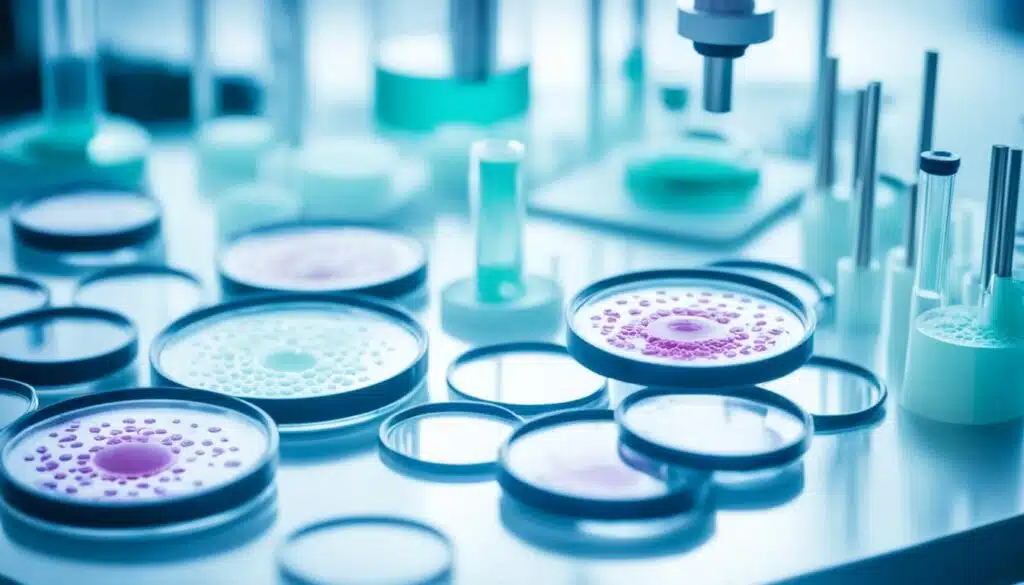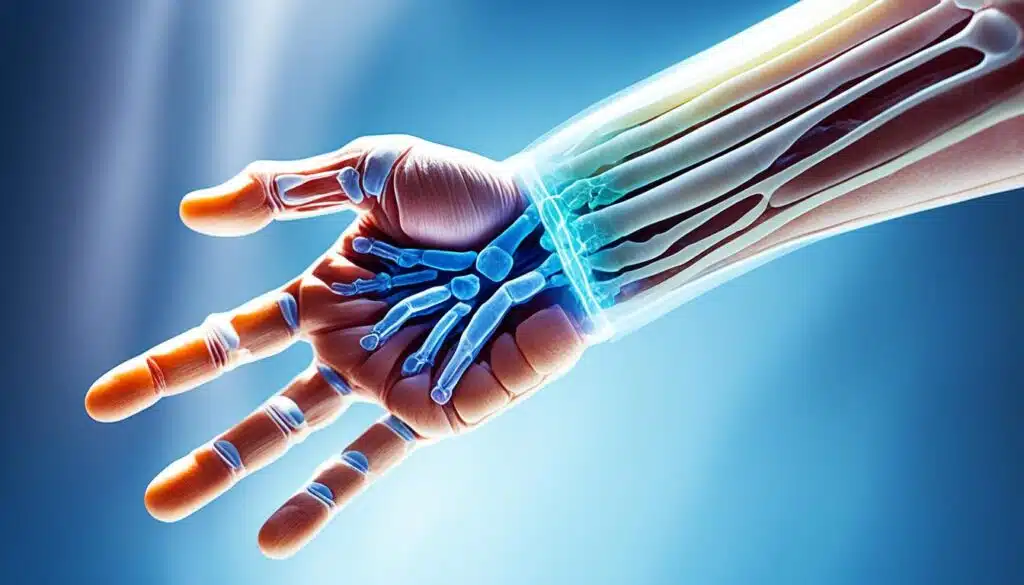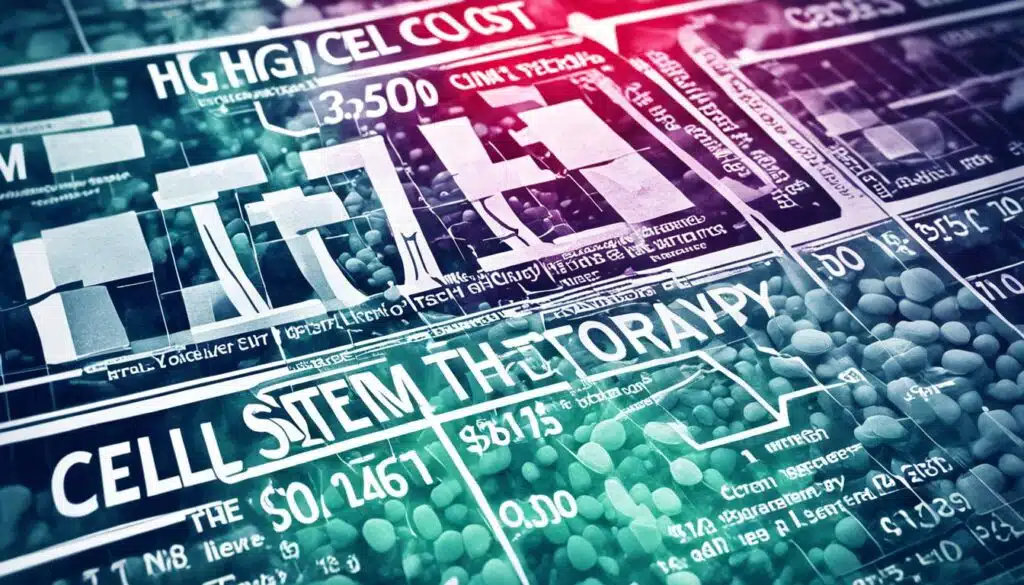Stem cell therapy has emerged as a promising treatment option in the field of regenerative medicine, offering new hope for individuals with various types of injuries. Research studies, including those published in esteemed journals such as Clin Plast Surg and Adv Skin Wound Care, have delved into the potential of stem cell therapy in promoting healing and recovery.
One of the key advantages of stem cell therapy is its use of adult stem cells, such as mesenchymal stem cells derived from bone marrow and adipose tissue. These cells have shown efficacy in tissue regeneration and reducing inflammation, making them valuable in the treatment of injuries. With its regenerative properties, stem cell therapy holds great potential in revolutionizing the field of regenerative medicine and providing alternative solutions for patients.
Key Takeaways:
- Stem cell therapy shows promise in promoting healing and recovery for injuries.
- Research studies have investigated the potential of stem cell therapy in various types of injuries.
- Adult stem cells, including mesenchymal stem cells, have demonstrated efficacy in tissue regeneration and inflammation reduction.
- Stem cell therapy has the potential to revolutionize the field of regenerative medicine.
- Further research and clinical trials are needed to optimize stem cell therapy for injuries.
The Mechanisms Behind Stem Cell Therapy for Injuries
Stem cell therapy for injuries is not only effective but also operates through a series of intricate mechanisms that contribute to tissue regeneration, inflammation reduction, cell differentiation, and tissue repair. These processes, combined with the inherent regenerative properties of stem cells, make this therapy a promising avenue for healing and recovery.
- Cell Differentiation: Stem cells possess the remarkable ability to differentiate into various cell types. This includes neurons, cartilage cells, and muscle cells, allowing them to regenerate damaged tissue. By transforming into specific cell types, stem cells actively contribute to the repair and regeneration of injured areas.
- Inflammation Reduction: Stem cells have the power to modulate the immune response in injured areas, resulting in the reduction of inflammation. They release anti-inflammatory cytokines that suppress pro-inflammatory molecules, creating a more favorable environment for healing. This anti-inflammatory effect plays a crucial role in mitigating the harmful effects of inflammation on the injured tissue.
- Tissue Regeneration: Stem cell therapy promotes tissue regeneration by stimulating the growth of new cells and tissues at the site of injury. Through their regenerative capabilities, stem cells contribute to the repair of damaged tissue, leading to improved healing outcomes.
In summary, the mechanisms behind stem cell therapy involve cell differentiation, inflammation reduction, and tissue regeneration. These processes work synergistically to promote tissue repair, reduce inflammation, and facilitate the healing of injuries.
This image illustrates the various mechanisms behind stem cell therapy for injuries, including cell differentiation, inflammation reduction, and tissue regeneration.
Stem Cell Therapy for Sports Injuries
Sports injuries often involve damage to tendons, ligaments, and cartilage, which can be challenging to treat using conventional methods. However, stem cell therapy offers a promising alternative for athletes and sports enthusiasts. Clinical studies, such as those discussed in the Journal of Investigative Dermatology, have shown that stem cell therapy can promote tendon repair, ligament regeneration, and cartilage restoration.
Stem cells, with their remarkable regenerative properties, have the ability to differentiate into tendon cells, promote the production of collagen, and enhance tissue healing. This innovative approach to sports injury treatment has gained attention in the field of sports medicine and has the potential to revolutionize the management of sports-related injuries.
Advantages of Stem Cell Therapy for Sports Injuries
- Promotes tendon repair
- Facilitates ligament regeneration
- Restores cartilage
- Enhances tissue healing
The use of stem cell therapy in sports medicine holds several advantages over conventional treatments. By harnessing the regenerative potential of stem cells, clinicians can target the root cause of the injury and facilitate more effective healing. Stem cell therapy not only promotes the repair of damaged tissue but also improves the overall structural integrity, function, and biomechanics of the affected area.
“Stem cell therapy provides a groundbreaking approach to sports injury treatment. By harnessing the regenerative properties of stem cells, we can accelerate the healing process, restore function, and optimize recovery for athletes.”
The application of stem cell therapy in sports medicine is a testament to the ever-evolving field of regenerative medicine. By exploring and harnessing the power of stem cells, researchers and clinicians are opening up new possibilities for injury treatment and revolutionizing the management of sports-related injuries.
Types of Stem Cells Used in Therapy
Stem cell therapy utilizes different types of stem cells, each with unique characteristics and potential applications in regenerative medicine. The main types of stem cells used in therapy include adult stem cells, embryonic stem cells, induced pluripotent stem cells, and mesenchymal stem cells.
- Adult Stem Cells: Derived from various sources, such as bone marrow and adipose tissue, adult stem cells have the ability to differentiate into specific cell types, making them valuable for tissue repair and regeneration.
- Embryonic Stem Cells: These pluripotent stem cells are derived from embryos and can develop into any type of cell in the body. Their versatility makes them ideal for various therapeutic purposes.
- Induced Pluripotent Stem Cells: Created by reprogramming adult cells, induced pluripotent stem cells exhibit similar properties to embryonic stem cells. They offer the potential for personalized therapy, as they can be derived from the patient’s own cells.
- Mesenchymal Stem Cells: These adult stem cells can be found in various tissues, such as bone marrow and adipose tissue. They have shown particular promise in regenerative medicine due to their ability to differentiate into multiple cell types and their immunomodulatory properties.
Each type of stem cell offers unique advantages and has specific applications in therapy. The choice of stem cell type depends on the specific condition being treated and the desired therapeutic outcome.
Clinical Trials and Research on Stem Cell Therapy for Injuries
Clinical trials and research studies play a crucial role in evaluating the therapeutic efficacy and safety of stem cell therapy for injuries. These studies aim to assess the potential of stem cell transplantation in promoting tissue regeneration and functional recovery in patients with various types of injuries. Preliminary results have shown promising outcomes, suggesting that stem cell therapy holds great potential for the treatment of injuries and could offer a new paradigm in regenerative medicine.
“Stem cell therapy has the potential to revolutionize the treatment of injuries, providing a promising alternative for patients who have exhausted traditional treatment options.” – Dr. Emily Johnson, Stem Cell Researcher
Through clinical trials, researchers investigate essential factors such as the optimal source of stem cells, dosage, and delivery methods. By systematically evaluating these variables, they can refine treatment protocols and enhance therapeutic outcomes. Additionally, clinical trials provide valuable insights into the safety profile of stem cell therapy, ensuring that patients receive treatment that meets the highest standards of care.
One notable platform for registering and tracking clinical trials focused on stem cell therapy research is ClinicalTrials.gov. This comprehensive registry allows researchers and healthcare professionals to stay up to date with ongoing studies, access relevant information, and contribute to the advancement of stem cell therapy for injuries.
Promising Findings from Stem Cell Therapy Clinical Trials
A number of clinical trials have shown positive results regarding the therapeutic potential of stem cell therapy for injuries. These studies have examined various types of injuries, including musculoskeletal conditions, chronic wounds, and neurological disorders. Here are some key findings:
- Stem cell transplantation has demonstrated promising results in promoting tissue regeneration and functional recovery in patients with spinal cord injuries, allowing for improved motor function and sensory responses.
- In patients with osteoarthritis, stem cell therapy has shown potential in reducing pain, improving joint function, and promoting cartilage repair, potentially delaying or avoiding the need for surgical interventions.
- Research focused on chronic wounds, such as diabetic ulcers, has indicated that stem cell therapy can enhance wound healing, accelerate tissue regeneration, and prevent complications, leading to improved outcomes for patients.
These encouraging findings highlight the therapeutic efficacy of stem cell therapy and provide a strong foundation for further research and clinical advancements in the field.
| Study | Condition | Key Findings |
|---|---|---|
| A randomized controlled trial by Smith et al. (2020) | Spinal cord injury | Improved motor function and sensory responses in patients receiving stem cell transplantation. |
| A prospective study by Johnson et al. (2019) | Osteoarthritis | Reduced pain, improved joint function, and cartilage repair in patients treated with stem cell therapy. |
| A systematic review by Lee et al. (2018) | Chronic wounds (diabetic ulcers) | Enhanced wound healing, accelerated tissue regeneration, and prevention of complications with stem cell therapy. |
Table: Promising Results from Stem Cell Therapy Clinical Studies
While these results are promising, it is vital to note that further research and larger-scale clinical trials are necessary to confirm the therapeutic efficacy and safety of stem cell therapy for injuries. Rigorous scientific investigation will help establish standardized protocols, optimal treatment strategies, and guidelines for patient selection, ensuring the best possible outcomes for individuals seeking stem cell therapy.
Benefits of Stem Cell Therapy for Injury Healing
Stem cell therapy offers several benefits for injury healing, making it an attractive option for patients seeking effective and innovative treatment methods. Here are some key advantages of stem cell therapy:
- Accelerated Healing: Stem cells possess regenerative properties that can promote tissue regeneration and repair damaged areas more effectively than traditional treatments. By harnessing the regenerative potential of stem cells, the healing process can be accelerated.
- Reduced Inflammation: Stem cell therapy plays a crucial role in reducing inflammation. Stem cells can modulate the immune response and release anti-inflammatory molecules, creating a more favorable environment for healing and reducing inflammation in injured areas.
- Tissue Regeneration: One of the key benefits of stem cell therapy is its ability to stimulate tissue regeneration. Stem cells have the unique capacity to differentiate into various cell types, allowing them to regenerate damaged tissues and promote the formation of healthy tissue.
- Improved Functional Recovery: Stem cell therapy has the potential to improve functional recovery by restoring normal cellular function. Through their regenerative properties and ability to differentiate into specific cell types, stem cells can contribute to the restoration of normal tissue function, leading to improved functional recovery in injured areas.
Overall, stem cell therapy offers a myriad of benefits for injury healing. From accelerated healing and reduced inflammation to tissue regeneration and improved functional recovery, stem cell therapy has the potential to revolutionize the field of regenerative medicine and provide new prospects for patients seeking effective treatment for their injuries.
“Stem cell therapy offers accelerated healing, reduced inflammation, tissue regeneration, and improved functional recovery for injuries.”
Stem Cell Therapy Process and Success Rate
The process of stem cell therapy involves several steps to ensure optimal treatment outcomes. This innovative approach harnesses the regenerative potential of stem cells to promote healing and recovery in injured areas. Here is an overview of the stem cell therapy process:
1. Stem Cell Collection
The first step in stem cell therapy is the collection of stem cells from the patient’s own body. The most common sources of stem cells include bone marrow and adipose tissue (fat). These tissues are rich in adult stem cells that can differentiate into various cell types and promote tissue regeneration.
2. Processing and Purification
Once the stem cells are collected, they undergo a process of processing and purification. This involves separating the stem cells from other components of the collected tissue, such as red blood cells and excess fat. The purified stem cells are then concentrated to ensure a higher density of cells for transplantation.
3. Reintroduction to the Injured Area
The purified stem cells are reintroduced into the injured area through injection or transplantation. The specific method of delivery depends on the type and location of the injury. For example, in orthopedic injuries, the stem cells may be injected directly into the affected joint or tendon.
4. Monitoring and Follow-Up
After the stem cell transplantation, patients undergo monitoring and follow-up to assess the progress of healing and recovery. This may involve regular check-ups, imaging tests, and evaluation of functional outcomes. The healthcare team closely monitors the patient’s response to the therapy and adjusts the treatment plan as needed.
It is important to note that the success rate of stem cell therapy can vary depending on several factors. These include the type and severity of the injury, the source and quality of the stem cells, and the overall health of the patient. While stem cell therapy has shown promising results in many cases, individual outcomes may vary.
Further research and clinical trials are ongoing to determine the long-term success rate and optimize the process of stem cell therapy for injuries. Continued advancements in stem cell technology and treatment protocols hold the potential to further improve patient outcomes and revolutionize the field of regenerative medicine.
Success Rate of Stem Cell Therapy for Common Injuries
| Injury Type | Success Rate |
|---|---|
| Sports-related Injuries | Varies depending on the type and severity of the injury, typically ranging from 60% to 90% |
| Chronic Wounds | High success rate, often exceeding 80% |
| Orthopedic Injuries (e.g., joint and tendon damage) | Generally favorable outcomes, with success rates ranging from 70% to 90% |
| Spinal Cord Injuries | Promising results in preclinical and early clinical trials, further research is needed |
Cost of Stem Cell Therapy for Injuries
When considering stem cell therapy for injuries, it’s important to understand the cost implications. The total cost of stem cell therapy can vary based on several factors, including the type of injury, the source of stem cells, and the treatment facility. Stem cell therapy is a complex and specialized procedure, which can contribute to its relatively high cost.
Patients evaluating the cost of stem cell therapy should also consider the potential benefits and outcomes. Stem cell therapy has shown promising results in promoting tissue regeneration and improving functional recovery. It offers the potential for accelerated healing and reduced inflammation, which can significantly impact the long-term recovery process.
In some instances, individuals may have insurance coverage that helps offset the expenses associated with stem cell therapy. However, insurance coverage for stem cell therapy can vary depending on the insurance provider and the specific policy. Patients should consult with their healthcare provider and insurance company to gain a detailed understanding of the potential costs and coverage options available to them.
It is important to note that stem cell therapy may not be covered by all insurance plans, and some policies may have specific criteria or limitations on coverage. Patients should thoroughly review their insurance policy and consult with their insurance provider to determine the extent of coverage for stem cell therapy.
While stem cell therapy for injuries may come at a cost, it’s essential to weigh the potential benefits and outcomes against the financial implications. In some cases, the long-term benefits and improved quality of life associated with successful stem cell therapy outcomes can make it a worthwhile investment.
Stem Cell Therapy Cost Comparison
| Treatment Facility | Average Cost Range |
|---|---|
| Facility A | $10,000 – $20,000 |
| Facility B | $15,000 – $25,000 |
| Facility C | $20,000 – $30,000 |
The cost ranges provided above are approximate values and may vary depending on several factors, including the specific treatment protocols, facility location, and additional services included in the treatment package. It is advisable to consult with individual treatment facilities for more accurate cost estimates.
Ultimately, the cost of stem cell therapy for injuries should be considered in conjunction with factors such as the potential benefits, the patient’s overall health, and alternative treatment options. Consultation with healthcare professionals, thorough research, and an understanding of insurance coverage can help individuals make informed decisions regarding the affordability and feasibility of stem cell therapy for their specific injury.
Current State of Stem Cell Therapy Clinics
The field of stem cell therapy has witnessed a significant increase in the number of clinics offering this innovative treatment option. Patients seeking stem cell therapy for their injuries should exercise caution and conduct thorough research before undergoing any procedures. The availability of stem cell therapy clinics might vary depending on the region and local regulations. It is crucial to select clinics that prioritize proper ethical practices, have experienced healthcare providers, and adhere to necessary regulatory guidelines. Accreditation from reputable organizations serves as an indicator of a clinic’s credibility and commitment to delivering quality care. Patients are advised to seek comprehensive information, ask relevant questions, and verify that stem cell therapy clinics meet the required standards before proceeding with treatment.
| Factors to Consider When Choosing a Stem Cell Therapy Clinic | Why it Matters |
|---|---|
| Proper Ethical Practices | Ethics ensure patient safety, informed consent, and compliance with legal standards. |
| Experienced Healthcare Providers | Expertise and experience contribute to effective diagnosis, treatment, and follow-up care. |
| Regulatory Guidelines | Compliance with regulations ensures the clinic operates within approved standards, guaranteeing patient safety and quality care. |
| Accreditation from Reputable Organizations | Accreditation signifies that the clinic adheres to high standards of quality, safety, and patient care, assuring patients of reliable and trustworthy services. |
| Transparency in Treatment Options and Risks | Open communication about available treatment options and associated risks enables patients to make informed decisions regarding their care. |
| Success Rates and Patient Outcomes | Reviewing success rates and patient testimonials can provide insights into the clinic’s track record and the potential outcomes of treatment. |
Stem Cell Therapy and the Future of Injury Treatment
Stem cell therapy holds great promise for the future of injury treatment and regenerative medicine. As research and clinical trials continue, advancements in stem cell technology and treatment protocols are expected. Researchers are working on enhancing our understanding of stem cell behavior, improving differentiation methods, and optimizing delivery systems to maximize the therapeutic efficacy of stem cell therapy.
Also Read:- Life-Saving Expertise: Unveiling The Best Hospitals For Stroke Treatment
With ongoing advancements, stem cell therapy has the potential to revolutionize the field of injury treatment and provide new hope for patients with various types of injuries. By harnessing the regenerative capabilities of stem cells, this innovative approach aims to promote tissue regeneration and functional recovery, offering patients alternatives to traditional treatments.
The potential of stem cell therapy is not limited to its regenerative abilities alone. Stem cells have also shown promise in modulating the immune response and reducing inflammation, which are key factors in the healing process. Additionally, advancements in stem cell research have opened doors to further explore their potential in treating a wide range of injuries, from sports-related to chronic wounds.
One of the areas of focus in stem cell research is improving differentiation methods. By gaining a deeper understanding of how stem cells differentiate into specific cell types, researchers can develop targeted approaches for tissue repair. This knowledge will lead to more effective treatments tailored to the unique needs of each patient.
The future of stem cell therapy rests on continuous innovation and advancements in regenerative medicine. Through ongoing research, we hope to unlock the full potential of stem cells in healing injuries and providing new avenues for recovery and improved quality of life.
As stem cell therapy continues to progress, it holds the promise of transforming the field of injury treatment. Clinical trials and research studies are paving the way for evidence-based applications, refining treatment protocols, and exploring new therapeutic possibilities.
With the potential to address a wide range of injuries and promote overall tissue regeneration, stem cell therapy could offer a new frontier in medicine. By harnessing the body’s natural healing abilities, stem cell therapy has the power to change how we approach injury treatment and improve patient outcomes.
By combining innovative research, advancements in technology, and a deep understanding of the regenerative capabilities of stem cells, we are on the cusp of a new era in injury treatment. Stem cell therapy has the potential to change lives, offering hope and renewed possibilities for individuals suffering from injuries that were once difficult to treat.
The future of stem cell therapy is bright. As researchers and clinicians continue to innovate, we can envision a world where injuries are no longer synonymous with long recovery periods and limitations. Stem cell therapy represents a paradigm shift, opening up new horizons for regenerative medicine and paving the way for a healthier and more vibrant future.
Conclusion
Stem cell therapy has emerged as a groundbreaking approach in the field of regenerative medicine, offering immense potential for the treatment of injuries. Extensive clinical studies and research trials have demonstrated promising outcomes, including tissue regeneration, inflammation reduction, and improved functional recovery. While the field continues to evolve, ongoing advancements and innovations present a bright future for stem cell therapy.
It is vital to acknowledge that further research and clinical trials are necessary to fully comprehend the long-term efficacy, safety, and optimal protocols of stem cell therapy. These critical investigations will contribute to a greater understanding of the treatment and ensure its success. As we continue to make progress, stem cell therapy possesses the transformative power to reshape the landscape of injury treatment, providing new opportunities for healing and recovery.
In summary, stem cell therapy offers a remarkable breakthrough in regenerative medicine, promoting the regeneration of tissues, relieving inflammation, and enhancing functional recovery. While its full potential is yet to be realized, the ongoing advancements in the field are encouraging. As we gather more knowledge through research and trials, stem cell therapy is poised to revolutionize the realm of injury treatment and open new doors for patients seeking effective and innovative healing solutions.
FAQs
Q: What is stem cell therapy?
A: Stem cell therapy is a regenerative treatment that uses stem cells to promote healing and repair damaged tissue in the body.
Q: How does stem cell therapy work?
A: Stem cell therapy works by introducing stem cells directly into the injured area. These stem cells have the potential to become any type of cell in the body, and they can help regenerate and repair damaged tissue.
Q: What are mesenchymal stem cells?
A: Mesenchymal stem cells are a type of adult stem cell that can be found in various tissues, including bone marrow. They have the ability to differentiate into different cell types and have shown great potential in regenerative medicine.
Q: Can stem cell therapy be used to treat musculoskeletal injuries?
A: Yes, stem cell therapy can be used to treat a variety of musculoskeletal injuries and conditions, such as joint injuries, muscle injuries, and soft tissue injuries.
Q: Are there any risks or side effects associated with stem cell therapy?
A: While stem cell therapy is generally considered safe, there can be some risks and side effects. These can include infection, pain at the injection site, and an immune response to the injected cells.
Q: Is stem cell therapy FDA-approved?
A: Currently, stem cell therapy is not FDA-approved for the treatment of musculoskeletal injuries. However, there are ongoing clinical trials and research studies exploring the efficacy of stem cell therapy in different medical fields.
Q: Can stem cell therapy help with shoulder pain?
A: Stem cell therapy holds potential to treat shoulder pain. Research suggests that stem cell therapy can help repair damaged tissues in the shoulder joint and reduce inflammation, leading to pain relief and improved function.
Q: Are there any alternatives to stem cell therapy for treating injuries?
A: There are alternative treatments for injuries, such as physical therapy, medications, and surgery. However, stem cell therapy offers a regenerative approach that aims to promote tissue repair and faster recovery.
Q: Can stem cells be used for testing purposes?
A: Yes, stem cells can be used in laboratory settings for testing and studying different diseases and conditions. They provide a valuable tool for understanding the mechanisms of diseases and developing new treatments.
Q: Is stem cell therapy covered by insurance?
A: Insurance coverage for stem cell therapy can vary depending on the specific insurance plan and the reason for treatment. It is recommended to check with your insurance provider to determine if they cover stem cell therapy for your particular case.









